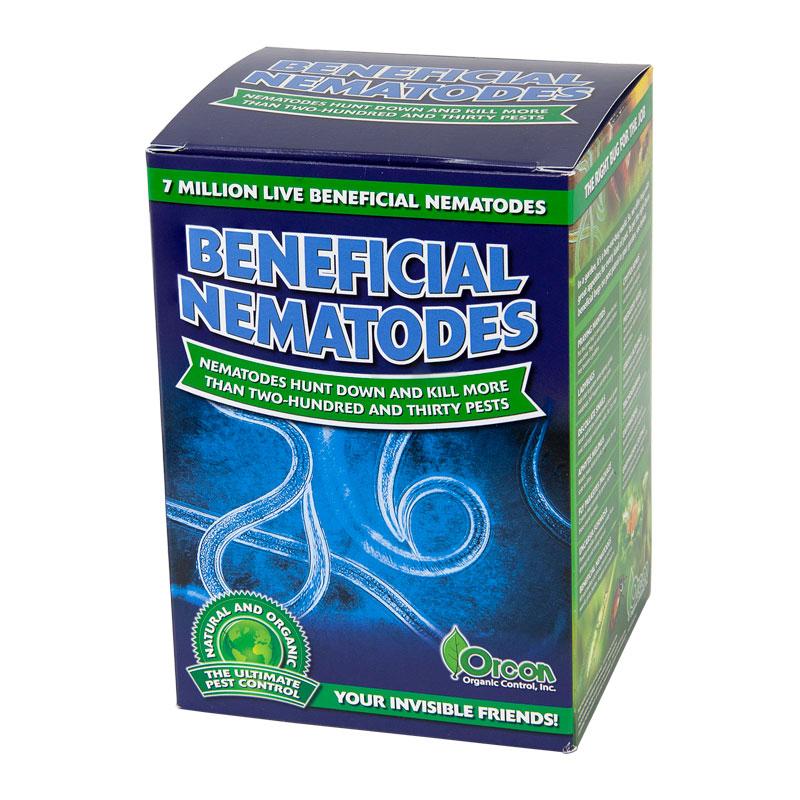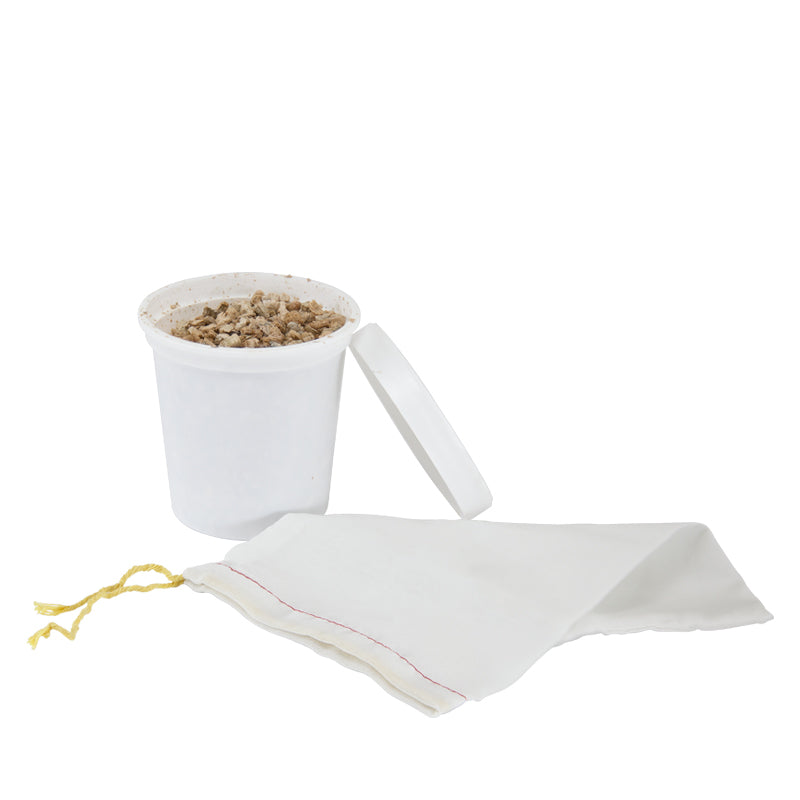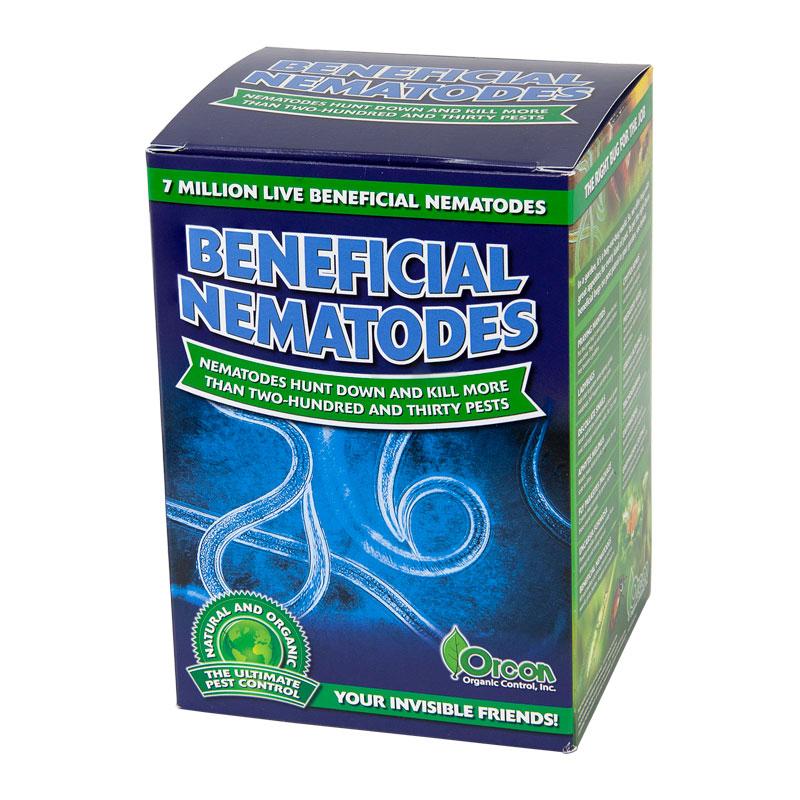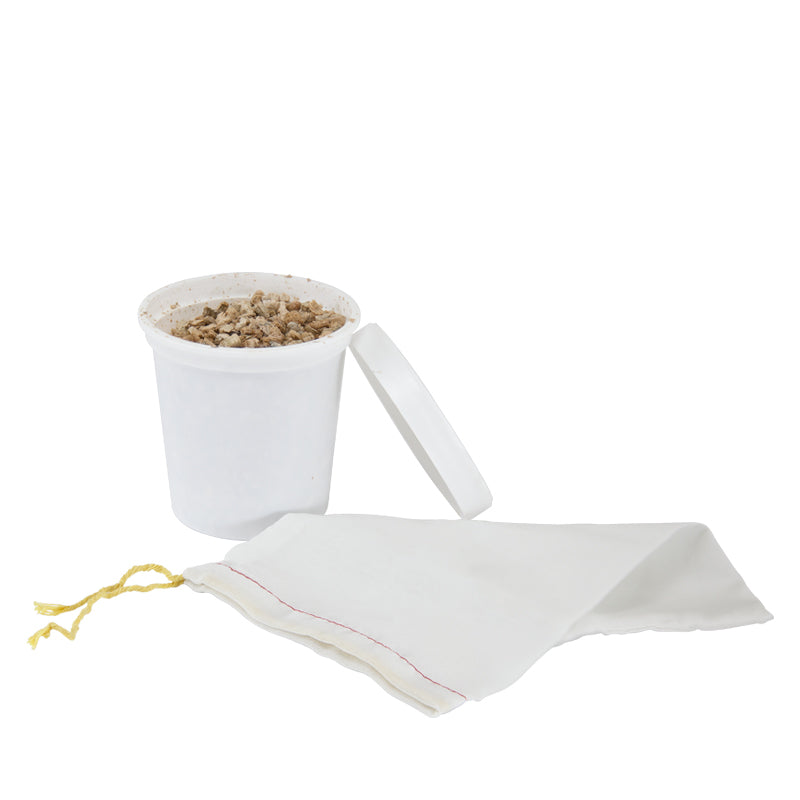Item Number: PBI035
Beneficial Nematodes (7 mil)
Beneficial Nematodes (7 mil)
Controls More Than 230 Different Insects
Utilizing Beneficial Nematodes for Effective Pest Control
Please note: There are no returns on this live product.
These microscopic organisms destroy pests that live underground. They will seek out and destroy more than 230 different kinds of soil dwelling and wood boring insects, including Japanese beetles, cut worms, wire worms, weevils, white grubs, fungus gnat larvae, flea larvae, subterranean termites, and many more.
Beneficial Nematodes (BN) will attack over wintering adult insects, pupae, diapausing larvae, and grubs when they are in the soil, bark, or even ground litter.
- Each container includes seven million live beneficial nematodes
- Contains Steinernema feltiae. They are microscopic in size and cannot be seen with the naked eye.
- Controls more than 230 kinds of soil dwelling and wood boring pests, such as flea larvae, white grubs, cutworms, corn root worms, strawberry weevils, gypsy moth larvae, cabbage root maggots, fungus gnat larvae, and many more.
- Will cover up to 2,000 square feet, but faster results are obtained with higher concentrations.
What are Nematodes?
Nematodes, also known as insect-fatal nematodes, are non-segmented roundworms belonging to the Phylum Nematoda. These tiny organisms form symbiotic relationships with certain bacteria, primarily from the genera Xenorhabdus and Photorhabdus, which are lethal to insect pests. When released into the soil, beneficial nematodes seek out and infect their target pests, ultimately leading to their demise.
Nematodes are important in pest control, providing a natural and eco-friendly solution to pest problems. These tiny organisms thrive in healthy soil, where they hunt down and attack insect pests, getting rid of them safely without harming human health. Nematodes can find pests by sensing carbon dioxide, which helps them locate and attack pests where they live.
By incorporating nematodes into pest management strategies, growers and gardeners can reduce reliance on chemical pesticides while promoting soil health and ecosystem balance. This method not only solves the immediate pest issue but also helps sustain the environment and keeps both plants and people healthy in the long term.
Benefits of Beneficial Nematodes:
Effective Pest Control: Nematodes are very good at controlling many kinds of insect pests, like beetle larvae, caterpillars, grubs, weevils, and others. They attack pests in their juvenile stages, making them an invaluable tool for preventing infestations and minimizing crop damage.
Environmentally Friendly: Unlike chemical pesticides, nematodes pose no risk to humans, pets, or non-target organisms. They specifically target insect pests, leaving beneficial insects, earthworms, and other soil organisms unharmed. This makes them an eco-friendly alternative for pest control in organic farming and gardening practices.
Sustainable Solution: Nematodes have the ability to reproduce and persist in the soil, providing long-term pest control benefits. Once they're in place, nematodes keep looking for and attacking pests, which helps keep pest numbers low without needing to reapply them.
Application Methods:
Soil Drench: To put nematodes in soil, mix them with water as the instructions say, then use a watering can, sprayer, or irrigation system to wet the soil. This method ensures even distribution of nematodes throughout the soil, targeting pests in their natural habitat.
Foliar Spray: To control pests like caterpillars or leaf miners on plants, you can spray nematodes on the leaves. Mix the nematodes with water and a sticker agent to help them stick to plant leaves, then spray the solution on the plants that need it.
Injection: If pests like tree borers or vine weevils are only in certain spots, you can inject beneficial nematodes straight into the soil or plant tissues using special equipment. This method delivers nematodes directly to the pest's habitat, maximizing effectiveness.
Effectiveness of Beneficial Nematodes:
Targeted Pest Control: Nematodes are picky about their targets, meaning they only go after certain pests. There are different types of nematodes to tackle specific pests, so pest control can be precise without hurting helpful insects.
Versatility: Beneficial nematodes can be used in gardens, lawns, greenhouses, and farms because they work well in different places. They work with integrated pest management (IPM) and can be used with other methods like biological, cultural, and mechanical controls.
Seasonal Control: Beneficial nematodes are most active and effective when soil temperatures are between 55°F and 85°F (13°C to 29°C). Therefore, timing applications to coincide with peak pest activity and favorable soil temperatures maximizes their efficacy.
Beneficial nematodes are valuable allies in the fight against insect pests, offering effective, environmentally friendly, and sustainable pest control solutions. Whether used in gardens, lawns, or agricultural fields, these microscopic organisms provide targeted control of pests while preserving beneficial insects and soil health. By integrating beneficial nematodes into pest management practices, growers and gardeners can achieve effective pest control while minimizing reliance on chemical pesticides and promoting ecological balance in their ecosystems.
Check Your Zone Compatibility:
Compatible with your zone.
Growing Zone for
,

Our Guarantee To You
Since 1976, we've served our customers at every stage of growing. Please contact us at any time. We are happy to support and assist you.
Description
Description
Utilizing Beneficial Nematodes for Effective Pest Control
Please note: There are no returns on this live product.
These microscopic organisms destroy pests that live underground. They will seek out and destroy more than 230 different kinds of soil dwelling and wood boring insects, including Japanese beetles, cut worms, wire worms, weevils, white grubs, fungus gnat larvae, flea larvae, subterranean termites, and many more.
Beneficial Nematodes (BN) will attack over wintering adult insects, pupae, diapausing larvae, and grubs when they are in the soil, bark, or even ground litter.
- Each container includes seven million live beneficial nematodes
- Contains Steinernema feltiae. They are microscopic in size and cannot be seen with the naked eye.
- Controls more than 230 kinds of soil dwelling and wood boring pests, such as flea larvae, white grubs, cutworms, corn root worms, strawberry weevils, gypsy moth larvae, cabbage root maggots, fungus gnat larvae, and many more.
- Will cover up to 2,000 square feet, but faster results are obtained with higher concentrations.
What are Nematodes?
Nematodes, also known as insect-fatal nematodes, are non-segmented roundworms belonging to the Phylum Nematoda. These tiny organisms form symbiotic relationships with certain bacteria, primarily from the genera Xenorhabdus and Photorhabdus, which are lethal to insect pests. When released into the soil, beneficial nematodes seek out and infect their target pests, ultimately leading to their demise.
Nematodes are important in pest control, providing a natural and eco-friendly solution to pest problems. These tiny organisms thrive in healthy soil, where they hunt down and attack insect pests, getting rid of them safely without harming human health. Nematodes can find pests by sensing carbon dioxide, which helps them locate and attack pests where they live.
By incorporating nematodes into pest management strategies, growers and gardeners can reduce reliance on chemical pesticides while promoting soil health and ecosystem balance. This method not only solves the immediate pest issue but also helps sustain the environment and keeps both plants and people healthy in the long term.
Benefits of Beneficial Nematodes:
Effective Pest Control: Nematodes are very good at controlling many kinds of insect pests, like beetle larvae, caterpillars, grubs, weevils, and others. They attack pests in their juvenile stages, making them an invaluable tool for preventing infestations and minimizing crop damage.
Environmentally Friendly: Unlike chemical pesticides, nematodes pose no risk to humans, pets, or non-target organisms. They specifically target insect pests, leaving beneficial insects, earthworms, and other soil organisms unharmed. This makes them an eco-friendly alternative for pest control in organic farming and gardening practices.
Sustainable Solution: Nematodes have the ability to reproduce and persist in the soil, providing long-term pest control benefits. Once they're in place, nematodes keep looking for and attacking pests, which helps keep pest numbers low without needing to reapply them.
Application Methods:
Soil Drench: To put nematodes in soil, mix them with water as the instructions say, then use a watering can, sprayer, or irrigation system to wet the soil. This method ensures even distribution of nematodes throughout the soil, targeting pests in their natural habitat.
Foliar Spray: To control pests like caterpillars or leaf miners on plants, you can spray nematodes on the leaves. Mix the nematodes with water and a sticker agent to help them stick to plant leaves, then spray the solution on the plants that need it.
Injection: If pests like tree borers or vine weevils are only in certain spots, you can inject beneficial nematodes straight into the soil or plant tissues using special equipment. This method delivers nematodes directly to the pest's habitat, maximizing effectiveness.
Effectiveness of Beneficial Nematodes:
Targeted Pest Control: Nematodes are picky about their targets, meaning they only go after certain pests. There are different types of nematodes to tackle specific pests, so pest control can be precise without hurting helpful insects.
Versatility: Beneficial nematodes can be used in gardens, lawns, greenhouses, and farms because they work well in different places. They work with integrated pest management (IPM) and can be used with other methods like biological, cultural, and mechanical controls.
Seasonal Control: Beneficial nematodes are most active and effective when soil temperatures are between 55°F and 85°F (13°C to 29°C). Therefore, timing applications to coincide with peak pest activity and favorable soil temperatures maximizes their efficacy.
Beneficial nematodes are valuable allies in the fight against insect pests, offering effective, environmentally friendly, and sustainable pest control solutions. Whether used in gardens, lawns, or agricultural fields, these microscopic organisms provide targeted control of pests while preserving beneficial insects and soil health. By integrating beneficial nematodes into pest management practices, growers and gardeners can achieve effective pest control while minimizing reliance on chemical pesticides and promoting ecological balance in their ecosystems.
Shipping Information
Shipping Information
Cannot ship to the following states: HI, PR, VI, GU
Cannot ship via SmartPost.
Shipping Weight: 2.0 lb
Dimensions: 7.0"L x 5.0"W x 4.0"H
Features
Features
Characteristics
Characteristics
Use Instructions
Use Instructions
Release: BN may be released by spraying with water, mixing with mulch and applying directly to the soil or potting mix, or injecting into burrows. They may be used any time of year, as long as the ground is not frozen. Do not release in direct sunlight, as this will kill them.
Application Directions: There are 3 ways to apply the Beneficial Nematodes (BN). Find your pest on the list at the bottom, then use the recommended treatment number.
Treatment 1-Top Dressing: Mix the entire contents of the container with ½ to 1 gallon of cold water. Stir well and let stand for ½ hour. Stir again and then add 5 to 6 quarts of vermiculite, peat moss or sandy humus. Spread mixture over the affected areas, then keep the area well watered for the next few days. For new plants or transplants, apply around roots. Apply after sundown because sunlight will kill BN. Water thoroughly after application because BN travel best in moisture.
Treatment 2-Spraying: Mix the entire contents of the container with ½ to 1 gallon of cold water, stir well and let stand for ½ hour. Water the area to be treated before application. Use a watering can, hose, sprayer, or pump sprayer. Always use the coarsest or highest setting to reduce damage to the BN. Stir the mixture again and pour into the sprayer, filtering out the carrier as you go (Use a kitchen strainer or a piece of window screen.) Add the left over carrier to your soil. Always agitate the water while spraying and before pouring because the BN sink to the bottom. Apply after sundown because sunlight will kill the BN. Water thoroughly after application because BN travel best in moisture.
Treatment 3-Injection: Mix the entire contents of the container with ½ gallon cold water. Stir well and let stand for ½ hour. Strain out the carrier (use a kitchen strainer or a piece of window screen), use the carrier in the soil, and let stand for another ½ hour. This allows most of the BN to sink to the bottom. Pour away the top water, saving the last pint. Use an eye dropper or squeeze bottle to inject about a tablespoon of liquid into the burrow. Seal the hole if possible.
PEST-USE NUMBERS BELOW TO SELECT TREATMENT ABOVE
- Artichoke Moth Larvae - Treatment 2: Spray Artichoke heads
- Black Currant Borers- Treatment 2: Spray cutting and bushes
- Black Vine Weevils-Treatment 1: Hoe into soil or add to potting soil
- Cabbage Root Maggots-Treatment 1: Put in seed furrows or on roots
- Carpenter Worms-Treatment 3: Inject burrows
- Coding Moth Larvae-Treatment 2: Spray tree trunks in Fall, Spring, Summer
- Corn Earworms-Treatment 2: Spray or 3: inject silks weekly
- Corn Rootworms-Treatment 1: Apply in seed furrows
- Cucumber Beetles-Treatment 1: Mix in mulch or apply in seed furrows
- Cutworms-Treatment 1: Apply as mulch, keep moist
- Flea Larvae-Treatment 2: Spray on lawns or soil, keep moist
- Flea Beetles-Treatment 1: Mix in mulch or apply in seed furrows
- Fungus Gnat Larvae-Treatment 1: Mix into potting soil
- Gypsy Moth Larvae-Treatment 2: Spray on lawns to kill migrating larvae
- Japanese Beetles-Treatment 2: Spray on lawns or 1: Mix into mulch
- Mole Crickets-Treatment 1: Apply to burrows, keep moist
- Onion Maggots-Treatment 1: Apply to furrows
- Poplar Clearwing Borers-Treatment 3: Inject burrows
- Raspberry Crown Borers-Treatment 1: Mix into soil near base
- Sod Webworms-Treatment 2: Spray onto sod, keep moist
- Strawberry Weevils-Treatment 1: Mix into soil and/or apply to roots
- Tobacco Budworms-Treatment 2: Spray or Treatment 3: Inject flowerbuds weekly
- Weevils-Treatment 1: Mix into mulch or on transplant roots
- White Grubs-Treatment 2: Spray or 1: Mix into soil
- Wireworms-Treatment 1: Apply to seed furrows or transplant roots
Storage: If not using immediately, store in the refrigerator. Once mixed with water, the BN can be stored for up to 24 hours in the refrigerator.
Useful Information
Useful Information
Guarantee
Guarantee
Share


Related Pages
- All Products |
- Beneficial Insects |
- Beneficial Nematodes |
- Codling Moth Traps, Lures & Insecticides for Apple & Other Fruit Trees |
- Cucumber Beetle Traps, Insecticides & Control for Damage Prevention |
- Cutworm Control & Damage Prevention for Gardens, Lawns & More |
- Earth Day 2023 |
- Farmer Favorites |
- Farmer Favorites - Pest Control, Fungus & Beneficial Insects |
- Flea Beetle Sprays, Insecticides & Treatment for Pest Control


